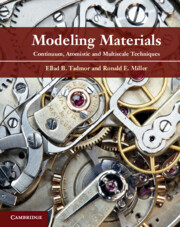Book contents
Preface
Published online by Cambridge University Press: 05 June 2012
Summary
Studying materials can mean studying almost anything, since all of the physical, tangible world is necessarily made of something. Normally, we think of studying materials in the sense of materials science and engineering – an endeavor to understand the properties of natural and man-made materials and to improve or exploit them in some way – but even this includes broad and disparate goals. One can spend a lifetime studying the strength and toughness of steel, for example, and never once concern oneself with its magnetic or electric properties. At the same time, modeling in science can mean many things to many people, ranging from computer simulation to analytical effective theories to abstract mathematics. To combine these two terms “modeling materials” as the title of a single book, then, is surely to invite disaster. How could it be possible to cover all the topics that the product modeling × materials implies? Although this book remains true to its title, it will be necessary to pick and choose our topics so as to have a manageable scope. To start with, then, we have to decide: what models and what materials do we want to discuss?
As far as modeling goes, we must first recognize the fact that materials exhibit phenomena on a broad range of spatial and temporal scales that combine together to dictate the response of a material. These phenomena range from the bonding of individual atoms governed by quantum mechanics to macroscopic deformation processes described by continuum mechanics.
Information
- Type
- Chapter
- Information
- Modeling MaterialsContinuum, Atomistic and Multiscale Techniques, pp. xiii - xvPublisher: Cambridge University PressPrint publication year: 2011
